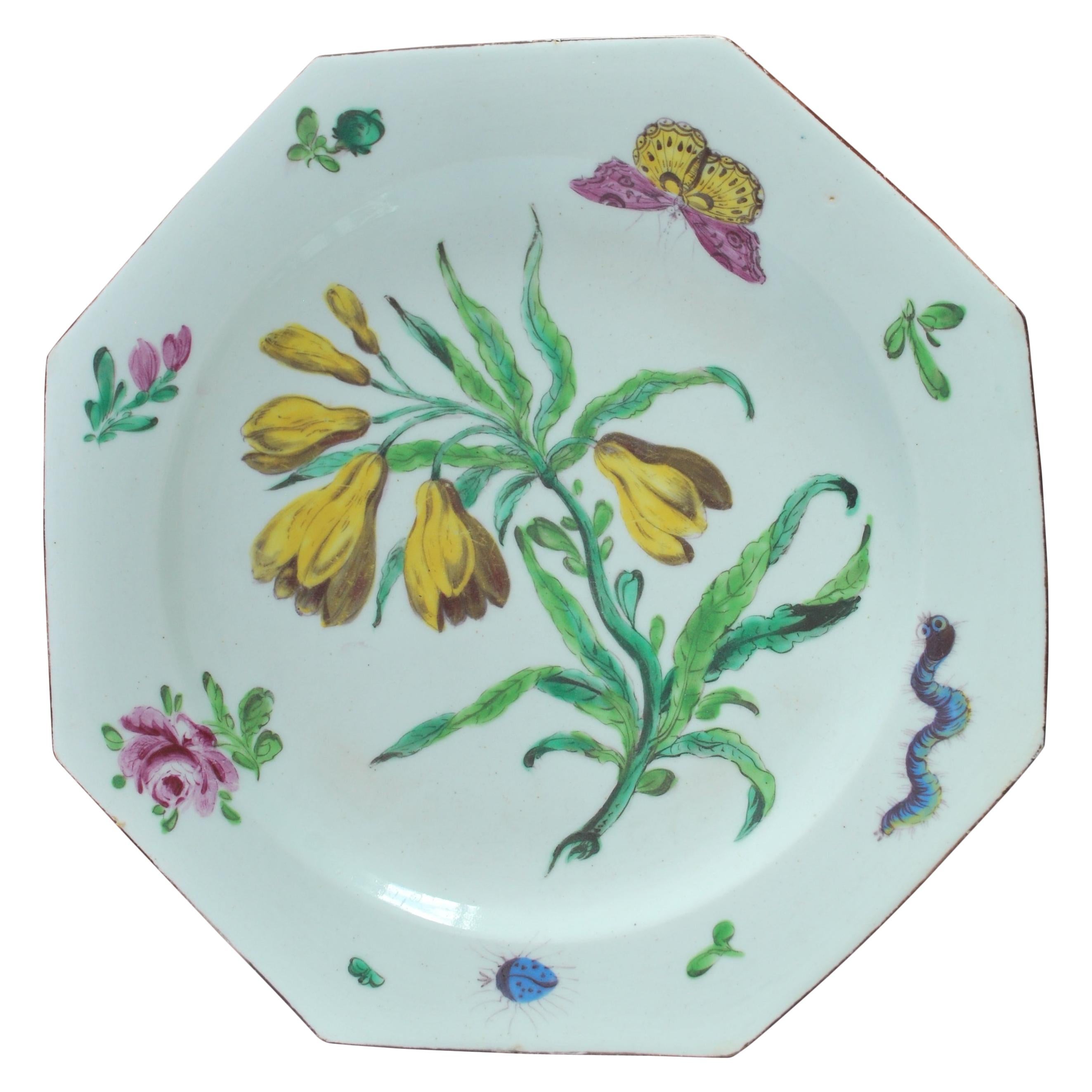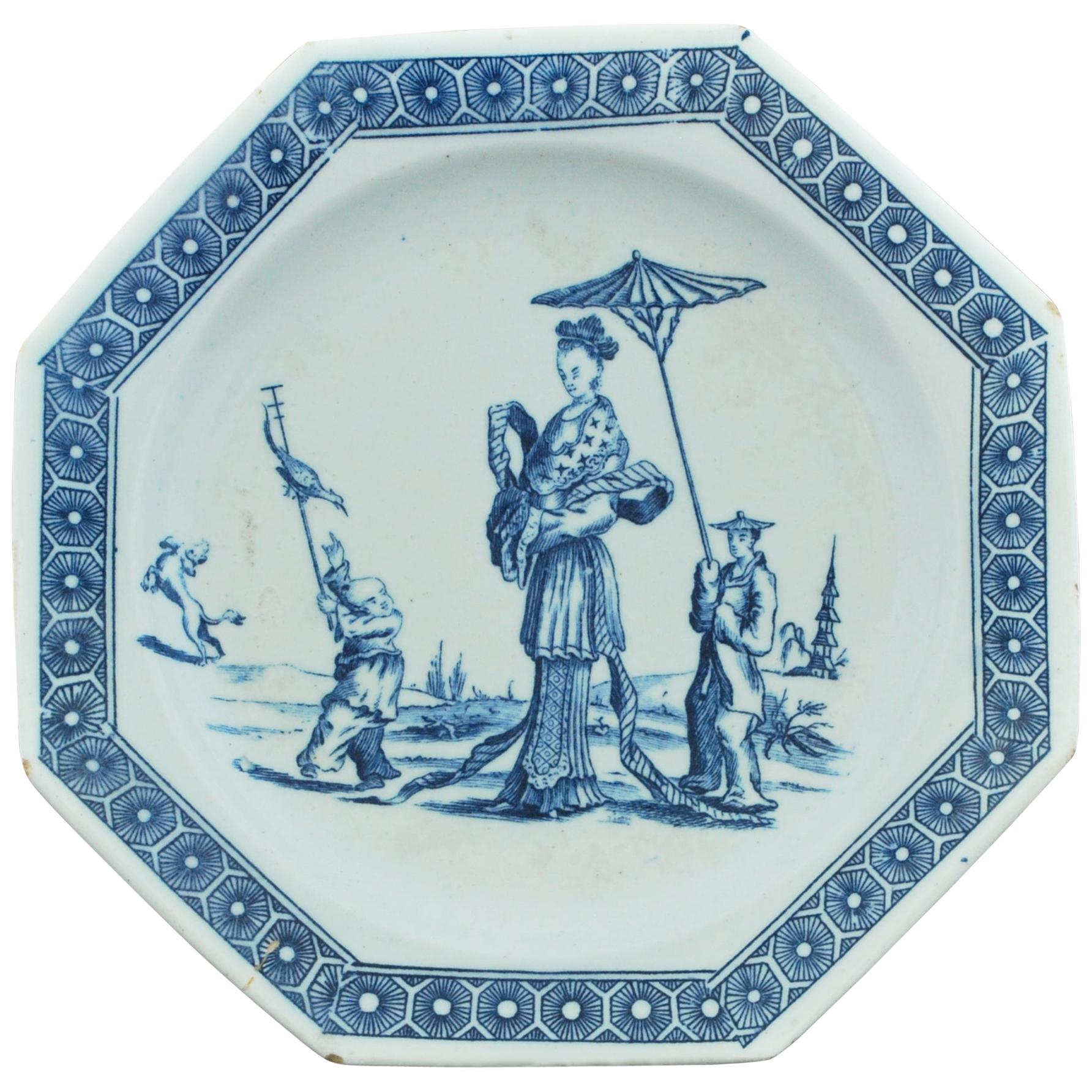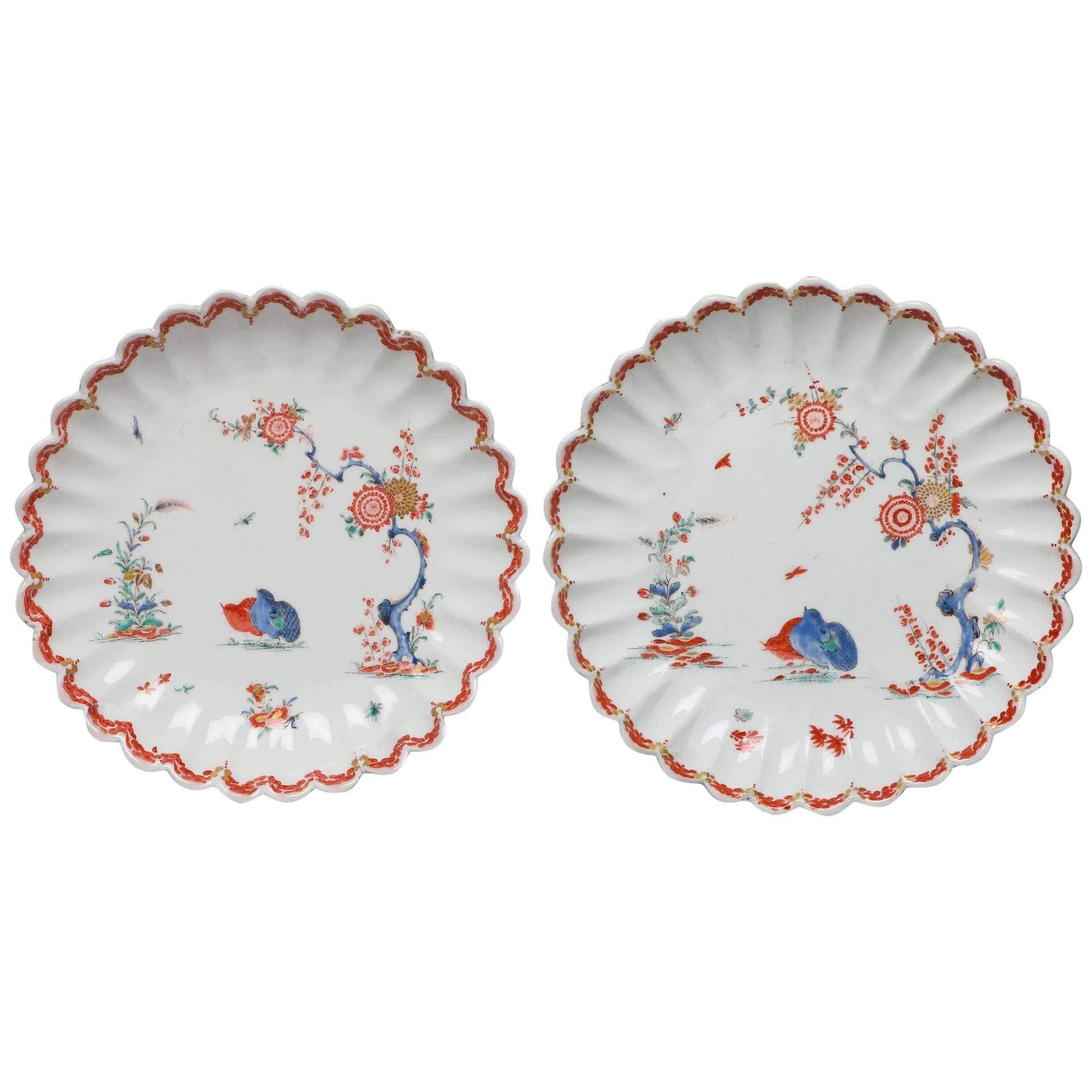Items Similar to Dated Crowther Plate, Bow Porcelain Factory, 1770
Want more images or videos?
Request additional images or videos from the seller
1 of 5
Dated Crowther Plate, Bow Porcelain Factory, 1770
About the Item
The so-called ‘Crowther Plate’ dated January 1770:
Octagonal, painted in blue underglaze with the monogram ‘RC’ in a floral cartouche and with elaborate scroll, pendant and cell and foliage rim borders with stylized pineapples. The underside in blue underglaze with the inscription ‘MR. ROBERT CROWTHER, STOCKPORT CHESHIRE, January 1770’.
Grey-white body with blued glaze. No discernible translucency. W. 8.4 in (21.3 cm). Provenance: Taylor Collection; Winifred Williams, UK, 1980.
Robert Crowther, a Stockport silk merchant was probably a relative of John Crowther, partner in the Bow undertaking.
Other examples, presumably from the same set: British Museum (Gift Henry Willett, 1886 [I.36]), (i) with inscription (illustrated, Bow Special Exhibition, 1959, Cat. #139, Figs 53 and 54) and (ii) without inscription; (iii) V&A, with inscription, (Wallace Elliot Bequest C.59-1938, illustrated Young, 1999, Plate 4) and (iv) Fitzwilliam Museum, Cambridge, with inscription (Accession #EC.8-1946, gift Nicholas Radford, 1946).
- Creator:Bow Porcelain (Manufacturer)
- Dimensions:Height: 0.5 in (1.27 cm)Diameter: 8.4 in (21.34 cm)
- Style:Neoclassical (Of the Period)
- Materials and Techniques:Porcelain,Molded
- Place of Origin:
- Period:1770-1779
- Date of Manufacture:1770
- Condition:
- Seller Location:Melbourne, AU
- Reference Number:
About the Seller
5.0
Gold Seller
These expertly vetted sellers are highly rated and consistently exceed customer expectations.
Established in 2005
1stDibs seller since 2017
69 sales on 1stDibs
Typical response time: 3 hours
- ShippingRetrieving quote...Ships From: Melbourne, Australia
- Return PolicyA return for this item may be initiated within 14 days of delivery.
More From This SellerView All
- Botanical Plate, Bow Porcelain Factory, circa 1755By Bow PorcelainLocated in Melbourne, VictoriaA fine octagonal plate painted in the botanical style; possibly the yellow gloriosa climbing lily. Provenance: Taylor Collection; Robyn Robb 2003. Filled edge chips.Category
Antique Mid-18th Century English Neoclassical Porcelain
MaterialsPorcelain
- Dessert Plate, Bow Porcelain Factory, circa 1756By Bow PorcelainLocated in Melbourne, VictoriaPlate, circa 1755-1760: Octagonal plate, the decoration after an oriental original (possibly from the region now modern Bhutan), with four robed ladies walking through a stylized lan...Category
Antique Mid-18th Century English Chinoiserie Porcelain
MaterialsPorcelain
- Dessert Plate, Bow Porcelain Factory, circa 1759By Bow PorcelainLocated in Melbourne, VictoriaPlate, circa 1758-1760: Small octagonal plate, the well printed in blue underglaze with La Dame Chinoise (also called the Promenade Chinoise) showing a tall oriental lady with tw...Category
Antique Mid-18th Century English Chinoiserie Porcelain
MaterialsPorcelain
- Dessert Plate, Bow Porcelain Factory, circa 1760By Bow PorcelainLocated in Melbourne, VictoriaCircular plate, the well outlined and transfer printed in black/brown outline and filled-in with 'wet' enamels all with Chinese figures in a garden and a child playing with an excite...Category
Antique Mid-18th Century English Chinoiserie Porcelain
MaterialsPorcelain
- Plate Disheveled Birds, Bow Porcelain Factory, circa 1767By Bow PorcelainLocated in Melbourne, VictoriaOf silver shape with lobed and gilt dentil edge; the well with a landscape of exotic birds enameled in a brilliant palette all on a festoon of dense green-black foliage, the rim with insects and exotic butterflies. The bird painter...Category
Antique Mid-18th Century English Chinoiserie Porcelain
MaterialsPorcelain
- Pair of Fluted Dessert Plates, Kakiemon Decoration, Bow Porcelain FactoryBy Bow PorcelainLocated in Melbourne, VictoriaEach of shallow circular form with scalloped rim and painted in the Kakiemon two Quail pattern with a pair of partridges standing between a flowering prunus and a kikyo bush amidst f...Category
Antique Mid-18th Century English Japonisme Porcelain
MaterialsPorcelain
You May Also Like
- 18th-cebtury Bow Porcelain Chinoiserie TankardBy Bow PorcelainLocated in Downingtown, PABow porcelain Chinoiserie tankard, Bow, London, 1760-1765. The unusually painted polychrome Bow porcelain tankard depicts Chinoiserie figure...Category
Antique Mid-18th Century English Georgian Barware
MaterialsPorcelain
- Plate Imperial Viennese Porcelain Manufactory dated 1816By Viennese Imperial Porcelain ManufactoryLocated in Vienna, ATQUITE RARE PICTURE PLATE OF VIENNESE IMPERIAL PORCELAIN MANUFACTORY: Stunning quality / edged areas are decorated with so-said Grotesque (Italian: GROTTESCHI) pattern. - Material is PORCELAIN (multicoloured painted). DATED 1816 (year's mark at reverse side visible: '816) Blue Beehive Mark (underglazed) of Austrian Imperial Porcelain...Category
Antique 19th Century Austrian Biedermeier Porcelain
MaterialsPorcelain
- Bow Porcelain Figure of Venus with Doves, Rococo, 1756-1764By Bow PorcelainLocated in London, GBThis is a rare and beautiful figure of Venus with two doves, made by the bow porcelain factory between 1756 and 1764. We see Venus standing holding her robe with one hand, a flower p...Category
Antique 1760s English Rococo Figurative Sculptures
MaterialsPorcelain
- Bow Porcelain Orphaned Coffee Cup, Famille Rose Peony, circa 1755By Bow PorcelainLocated in London, GBThis is a very charming orphaned coffee cup made by the Bow Porcelain factory in about 1755. The cup is decorated in a Chinese "famille rose" peony pattern. This cup would have been part of a large tea service, and the tiny size shows how expensive coffee was in the 18th Century. The Bow Porcelain Factory was one of the first potteries in Britain to make soft paste porcelain, and most probably the very first to use bone ash, which later got perfected by Josiah Spode to what is now the universally used "bone china". Bow was the main competitor of the Chelsea Porcelain Factory, but where Chelsea made very fine slipcast porcelain, Bow made a different soft paste porcelain that tended to be softer and could be pressed into moulds. Bow served a larger public generally at lower prices. The factory was only in operation between 1743 and 1774, after which the tradition got incorporated into some of the later famous potteries such as Worcester and Derby. The cup is unmarked, which is normal for Bow items of this era. Condition report the cup is in excellent condition without any damage or repairs. There are various glazing imperfections, which are quite normal for porcelain of this era. Antique British porcelain...Category
Antique 1750s English Rococo Tea Sets
MaterialsPorcelain
- Bow Porcelain Ocagonal Fan-Panelled Landscape Pattern Dish c1760By Bow PorcelainLocated in Tunbridge Wells, GBHeading : Bow porcelain octagnoal, fan panelled, underglaze powder blue, landscape pattern dish Date : c1760 Period : George III Marks :Faux Chinese marks Origin : New Canton - then...Category
Antique 1760s British George III Porcelain
MaterialsPorcelain
- Bow Pair of Porcelain Figures, Arlecchino and Columbina, Rococo ca 1758By Bow PorcelainLocated in London, GBThis is a wonderful pair of figures of Arlecchino and Columbina, made by the Bow Porcelain factory in about 1758. These figures formed part of a series of the Commedia dell'Arte, a very popular series of theatrical figures that served as decoration at the dinner table in the 18th Century. The Bow Porcelain Factory was one of the first potteries in Britain to make soft paste porcelain, and most probably the very first to use bone ash, which later got perfected by Josiah Spode to what is now the universally used "bone china". Bow was the main competitor of the Chelsea Porcelain Factory, but where Chelsea made very fine slipcast porcelain, Bow made a different soft paste porcelain that tended to be softer and could be pressed into moulds. Bow served a larger public generally at lower prices. The factory was only in operation between 1743 and 1774, after which the tradition got incorporated into some of the later famous potteries such as Worcester and Derby. These figures were used to adorn the dinner table when dessert was served; groups of figures served to express something about the host, the guests, or to direct the conversation. The Italian Commedia Dell'Arte, a comical form of masked theatre, was very popular in those days and Bow copied many figures of the German Meissen series that were brought out in the decades before. This pair dates from about 1758, which was at the height of Bow's ability to make beautiful figurines often copied from Chelsea or Meissen. The pair is modelled after a Meissen pair by Kaendler. The porcelain is translucent with a beautiful milky glaze - Bow was probably the first pottery using bone in its porcelain recipe. Arlecchino (Harlequin) is playing the bagpipes, dressed in an odd costume of mismatched chintz and playing cards and wearing a funny black trumpet...Category
Antique 1750s English Rococo Figurative Sculptures
MaterialsPorcelain
Recently Viewed
View AllMore Ways To Browse
Blue And White Porcelain Porcelain
Silk Bow
Blue Bow
Floral Bow
Bow Pendants
Blue And White Porcelain Floral
Grey Porcelain
Antique Silver Uk
Antique Glasses Uk
Octagonal Plate
Octagon Plate
V Monogram
White Porcelain Molds
Floral Plate Collection
Antique Plates Uk
Antique Bow Porcelain
Blue And White Floral Plate
Antique Ceramics Uk





